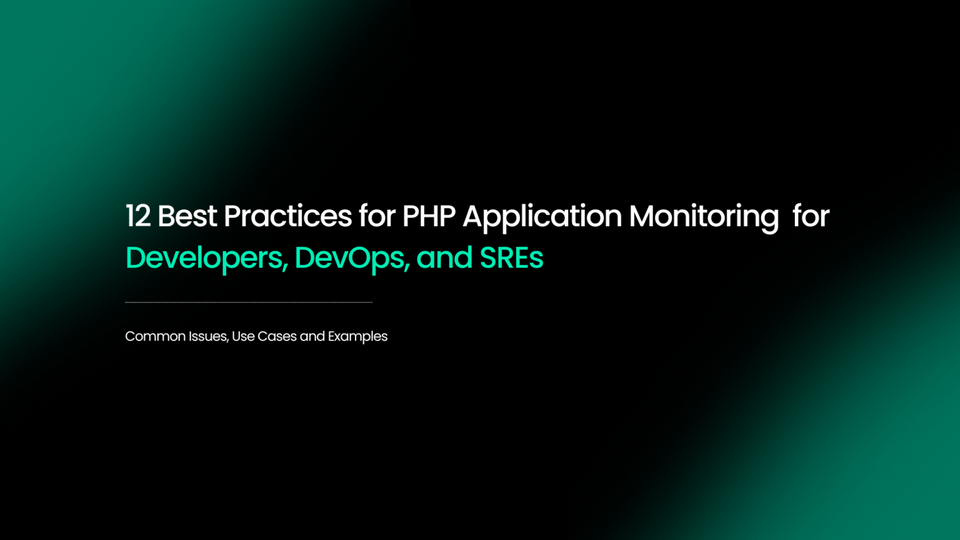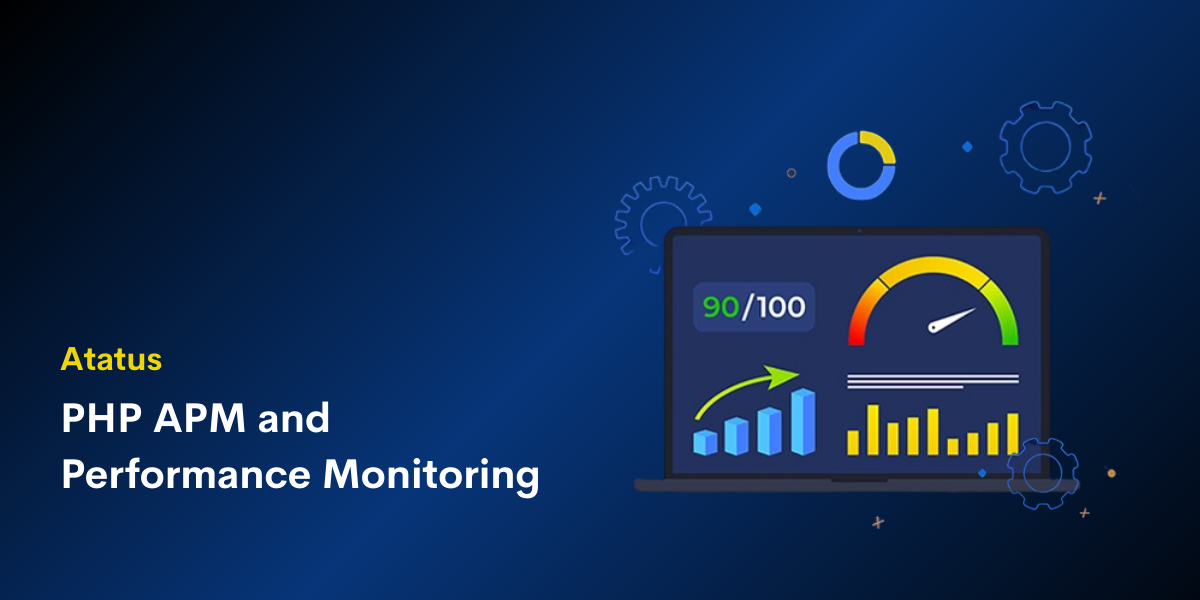What is PHP FPM? An In-Depth Guide
PHP is one of the most widely used server-side scripting languages, driving a significant portion of the web. As websites grow in complexity and traffic, optimizing PHP for performance and scalability becomes essential. PHP FPM (FastCGI Process Manager), is a tool designed to enhance PHP's efficiency. In this blog, we will explore what PHP FPM is, how it works, and why it is essential for modern web applications.
Table of Contents:
- Understanding PHP FPM
- Key features of PHP FPM
- How PHP FPM works?
- Benefits of PHP FPM
- Use cases for PHP FPM
- Getting started with PHP FPM
- Most used PHP FPM configurations
- Alternatives to PHP FPM
- Atatus PHP monitoring
Understanding PHP FPM
PHP FPM is an alternative PHP FastCGI implementation designed for handling high-performance applications. It works as a process manager for PHP scripts, allowing web servers to execute PHP efficiently.
Unlike traditional PHP setups, where PHP runs as a module within the web server, PHP FPM operates independently. It creates a pool of worker processes that execute PHP scripts and uses the FastCGI protocol to communicate with the web server.
Key features of PHP FPM
- Process management: PHP FPM manages multiple worker processes, ensuring efficient script execution without overloading the server.
- Performance optimization: By maintaining a pool of pre-spawned processes, PHP FPM reduces the overhead of starting and stopping processes for every request.
- Scalability: PHP FPM is highly configurable, allowing adjustments to suit low-traffic sites and high-demand enterprise applications.
- Improved reliability: Features like request timeouts and process limits help prevent server crashes caused by poorly written scripts or unexpected spikes in traffic.
How PHP FPM works?
PHP FPM improves the performance of PHP applications by managing how web servers like NGINX, Apache, or Lighttpd interact with PHP scripts. It uses the FastCGI protocol to handle requests and assigns them to worker processes in an efficient way. Let’s break down how PHP FPM works.

The FastCGI Protocol
PHP FPM communicates with web servers like NGINX, Apache, or Lighttpd using the FastCGI protocol. FastCGI acts as a middleman, passing requests from the web server to PHP FPM and sending back the output to the client.
Process Pooling
When a request comes in, PHP FPM assigns it to an available worker process from its pool. This pool operates under one of the following modes:
- Static: A fixed number of worker processes are always running.
- Dynamic: The number of processes adjusts based on traffic demand.
- On-Demand: Processes are created and terminated as needed, minimizing idle resource usage.
Example integration with NGINX:
location ~ \.php$ {
include fastcgi_params;
fastcgi_pass 127.0.0.1:9000;
fastcgi_param SCRIPT_FILENAME $document_root$fastcgi_script_name;
}
Benefits of PHP FPM
- Enhanced performance: PHP FPM pre-spawns worker processes, reducing the overhead of creating a new process for each request. This makes it ideal for high-traffic websites.
- Resource management: Features like
pm.max_children(maximum number of processes) andpm.max_requests(requests per process before respawning) allow fine-grained control over resource allocation. - Improved fault tolerance: PHP FPM can terminate processes that exceed predefined limits, such as execution time or memory usage, preventing a single request from impacting overall server performance.
- Better integration with web servers: PHP FPM works seamlessly with web servers like NGINX and Apache, enabling modern setups with improved load balancing and caching capabilities.
- Secure multi-tenancy: PHP FPM supports running worker processes under different user accounts, isolating applications and enhancing security in shared hosting environments.
Use cases for PHP FPM
- High-traffic websites: E-commerce platforms, news websites, and large-scale applications benefit from PHP FPM's ability to handle multiple concurrent requests efficiently.
- Shared hosting environments: Hosting providers use PHP FPM to isolate users and allocate resources fairly, ensuring one user doesn't affect another.
- Performance-critical applications: Applications requiring low latency and high reliability, such as APIs and real-time platforms, leverage PHP FPM for optimized performance.
Getting started with PHP FPM
1. Installation
Most Linux distributions provide PHP FPM packages. For example, on Ubuntu:
sudo apt install php-fpm
2. Configuration
The main configuration file (php-fpm.conf) and pool-specific files (/etc/php/7.x/fpm/pool.d/*.conf) allow you to tailor PHP FPM settings.
Key parameters include:
pm(static, dynamic, or ondemand)pm.max_children(maximum worker processes)request_terminate_timeout(maximum script execution time)
3. Integration with Web Servers
For NGINX, configure the fastcgi_pass directive to point to PHP FPM:
location ~ \.php$ {
include fastcgi_params;
fastcgi_pass 127.0.0.1:9000;
fastcgi_param SCRIPT_FILENAME $document_root$fastcgi_script_name;
}
Restart both the web server and PHP FPM after configuration changes:
sudo systemctl restart php-fpm
sudo systemctl restart nginx
Most used PHP FPM configurations
Here are some commonly used PHP FPM configurations, their roles, and their impact on performance and resource management:
1. pm (Process Manager):
The pm directive defines the process management mode for PHP-FPM, determining how worker processes are managed.
Options:
static: A fixed number of child processes are created and remain active.dynamic: Adjusts the number of child processes based on traffic demands.ondemand: Processes are spawned only when needed and terminated after a defined idle time.
Use Cases:
- Use static for predictable, high-traffic workloads where you need consistent resource allocation.
- Use dynamic for environments with variable traffic.
- Use ondemand for low-traffic or resource-constrained servers.
2. pm.max_children:
The pm.max_children defines the maximum number of child processes that can be created to handle requests. This setting directly impacts the number of concurrent requests the server can manage. Setting this too high may deplete server memory, while a lower value might cause request delays. The default value typically ranges between 5 and 10, depending on the distribution.
3. pm.start_servers, pm.min_spare_servers, pm.max_spare_servers:
These directives apply when pm is set to dynamic and help manage worker processes during varying traffic conditions.
pm.start_servers: Number of child processes to start initially.pm.min_spare_servers: Minimum number of idle worker processes to maintain.pm.max_spare_servers: Maximum number of idle worker processes allowed.
4. pm.max_requests:
Specifies how many requests a worker process can handle before it is respawned. It helps mitigate memory leaks from third-party libraries. The default value is typically set to 500.
5. request_terminate_timeout:
Sets the maximum execution time for a single request.If a request exceeds this limit, the corresponding process is terminated, preventing long-running scripts from consuming resources. The default value is 0, which means it is disabled.
6. listen:
Configures the address (UNIX socket or IP:port) where PHP FPM listens for FastCGI requests.
Example:
listen = 127.0.0.1:9000
listen = /var/run/php/php7.4-fpm.sock7. user and group:
The user and group settings specify the user and group under which PHP-FPM worker processes operate. This enhances security by isolating the processes and preventing unauthorized access to server resources.
8. access.log, slowlog
The access.log file logs all requests processed by PHP-FPM, providing valuable insights for performance monitoring and debugging. The slowlog records details of slow requests, helping to identify bottlenecks or problematic scripts that may require optimization. These logs are crucial for maintaining server efficiency and improving performance.
Alternatives to PHP FPM
While PHP FPM is a robust and widely adopted solution, there are alternatives to consider based on specific requirements:
1. Apache mod_php
Runs PHP as an Apache module, allowing PHP to be executed directly within the web server.
Pros:
- Simple to configure.
- Tight integration with Apache.
Cons:
- Less efficient for handling concurrent connections.
- Tied to Apache, limiting web server flexibility.
Use Case: Suitable for smaller applications where simplicity is a priority.
2. HHVM (HipHop Virtual Machine)
An alternative PHP runtime developed by Meta (formerly Facebook). It supports PHP and Hack.
Pros:
- Extremely fast for specific workloads.
- Designed for high-performance environments.
Cons:
- Limited support for newer PHP features and versions.
- Smaller community and ecosystem compared to PHP FPM.
Use Case: Large-scale applications requiring maximum performance.
3. CGI and FastCGI
CGI is a traditional method to execute scripts, while FastCGI is an optimized version that reuses processes.
Pros:
- Simple to set up.
- Works with various web servers.
Cons:
- CGI is slow due to the process-per-request model.
- FastCGI lacks some advanced features of PHP FPM.
Use Case: Legacy setups or environments requiring simplicity.
4. uWSGI
A versatile application server that can run PHP scripts.
Pros:
- Supports multiple languages.
- Highly configurable.
Cons:
- More complex setup compared to PHP FPM.
- Larger memory footprint.
Use Case: Multi-language applications requiring advanced features.
5. Node.js or Other Language Stacks
For some applications, replacing PHP entirely with Node.js, Python, or Go may offer better performance or scalability.
Pros:
- Modern, event-driven architectures.
- Rich ecosystem.
Cons:
- Requires rewriting applications.
- May not be ideal for legacy PHP projects.
Use Case: New projects with flexibility in choosing technologies.
Atatus PHP FPM monitoring: Enhance Your Application's Performance Effortlessly
Atatus PHP FPM Monitoring offers a robust solution for monitoring and enhancing the performance of your PHP FPM applications. It provides real-time insights into server performance, identifies bottlenecks, and ensures smooth operation of your web applications.
Key Features of Atatus PHP FPM Monitoring
- Detailed PHP FPM metrics: Monitor key metrics like process utilization, request rates, idle processes, and memory usage to ensure your PHP FPM pools are performing optimally.
- Worker process insights: Track the performance of each worker process in the pool, including request handling times, process spawning, and termination events.
- Slow request detection: Identify long-running PHP requests and analyse their root causes with detailed slow log monitoring. Optimize scripts to reduce execution times and improve user experience.
- Customizable alerts: Set thresholds for critical PHP FPM metrics like memory usage, request processing time, or idle process count. Receive instant notifications when thresholds are reached.
- Integration with Web Servers: Seamlessly integrate Atatus PHP FPM Monitoring with popular web servers like NGINX, Apache, and Lighttpd. Track interactions between your web server and PHP FPM to ensure smooth communication.
#1 Solution for Logs, Traces & Metrics
APM
Kubernetes
Logs
Synthetics
RUM
Serverless
Security
More





